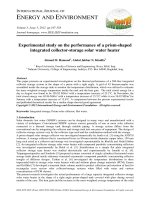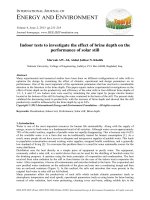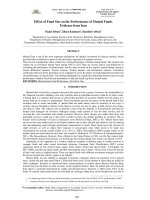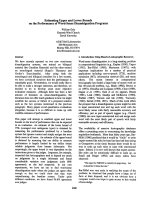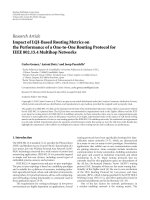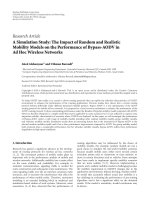On the performance of multicarrier CDMA (MC CDMA) systems with transmit diveristy
Bạn đang xem bản rút gọn của tài liệu. Xem và tải ngay bản đầy đủ của tài liệu tại đây (699.22 KB, 96 trang )
ON THE PERFORMANCE OF MULTICARRIER CDMA
(MC-CDMA) SYSTEMS WITH TRANSMIT DIVERSITY
HE TAO
NATIONAL UNIVERSITY OF SINGAPORE
2003
ON THE PERFORMANCE OF MULTICARRIER CDMA
(MC-CDMA) SYSTEMS WITH TRANSMIT DIVERSITY
HE TAO
A THESIS SUBMITTED
FOR THE DEGREE OF MASTER OF ENGINEERING
DEPARTMENT OF ELECTRICAL AND COMPUTER ENGINEERING
NATIONAL UNIVERSITY OF SINGAPORE
2003
ACKNOWLEDGEMENTS
I would like to thank my advisor, Nallanathan Arumugam, for his continuous support
of me at NUS. I would never have gotten to the point of even starting this dissertation,
without his advice and support. He was always there to meet and talk about my ideas and
mark up my papers. He kept me thinking when I thought I had run into a fatal problem.
I would also like to thank my co-advisor, H.K. Garg. His good guidance, support and
encouragement benefit me in overcoming obstacle on my research path.
Besides my advisor, there has been one personnel who is most responsible for helping
me complete this challenging program, Bo Yang, my wife. She has been a great friend
and guider in both my chosen field and in the rest of my life.
I am also grateful to Bharadwaj Veeravalli , supervisor of the OSSL Lab, Department
of Electrical and Computer Engineering, National University of Singapore, who provides
the research facilities to conduct the research work.
i
TABLE OF CONTENTS
Acknowledgements
i
Table of Contents
ii
Summary
iv
List of Figures
vi
List of Tables
viii
Chapter I
1
Introduction
1
1.1 Background and Scope
1
1.2 Literature Review
2
1.3 Contribution
8
1.4 Thesis outline
10
Chapter II
12
ST Block Coded MC-CDMA over Frequency Selective Channel
12
2.1 Space-Time Block Code
13
2.2 Channel Model
20
2.3 Transmitter Model
28
2.4 Receiver Model
30
2.5 Simulation Results
32
Chapter III
34
SF Block Coded MC-CDMA over Fast Fading Channel
34
3.1 Transmitter Model
35
3.2 Receiver Model
36
3.3 Error Probability Analysis
39
3.3.1Theoretical Bit Error Probability
39
ii
3.3.2 Upper Bound of Bit Error Probability
3.4 Simulation Results
Chapter IV
41
44
49
STF Block Coded MC-CDMA over Time and Frequency Selective Fading
Channel
49
4.1 Transmitter Model
52
4.2 Receiver Model
53
4.3 Simulation Results
55
Chapter V
60
Multiuser Receiver for Asynchronous ST coded CDMA System
60
5.1 Introduction
60
5.2 System Model
61
5.3 Iterative Multiuser Receiver
63
5.4 Non-iterative Multiuser Receiver
69
5.5 Simulation Results
71
5.6 Conclusions
74
Chapter VI
76
Conclusion and Future Works
76
6.1 Conclusion
76
6.2 Future Work
78
REFERENCES
80
iii
SUMMARY
Transmit diversity techniques combined with error control coding have explored a
new scheme called space-time (ST) block coding. Because of the orthogonal structure of
the ST block code, the maximum-likelihood decoding could be used at the receiver
without complicated non-linear operations. The space-frequency (SF) block coding and
space-time-frequency (STF) block coding are developed on the basis of the ST block
coding, but the encoding is carried out in different domains. This thesis analyzes the
performance of the multicarrier (MC)-CDMA systems that use different transmit
diversity schemes over different fading channels.
The structure and performance of MC-CDMA systems that use ST block code are
presented over frequency selective fading channel. The encoding and decoding
procedures are given in details. The simulation results justify that the ST block code
system performs much better than uncoded system over the frequency selective channel.
The transceiver solution and performance of the SF block coded MC-CDMA system
are presented over time selective fading channel. It is shown that the SF coding gives
good performance over time selective fading channels where the ST block coding does
not perform effectively. With two transmit antennas, SF block code can provide a
diversity order of 2 M with M receive antennas, which is same as in the ST block code
case. The theoretical bit error probability of the SF block coded MC-CDMA systems is
iv
analyzed. Since the analytical expression of the theoretical bit error probability is difficult
to obtain, we deduce its upper bound.
The STF block coded MC-CDMA system with a 4 × 4 transmission matrix is
considered over a fast frequency selective fading channel. It is verified that STF block
code outperforms ST and SF block code over fast frequency selective fading channel.
This is because the condition of the orthogonality for the STF block coded system is
more relaxed than that for the ST block coded or SF block coded systems.
An important issue related to the CDMA systems is discussed. The thesis suggests an
iterative multi-user interference cancellation scheme which combines the decorrelating
detector and parallel interference canceller for ST-block coded asynchronous DS-CDMA
system. The performance of the system with iterative multi-user receiver is presented and
compared with the conventional ST coded CDMA system.
The thesis is then concluded with the remarks and the summary of some promising
future research directions.
v
LIST OF FIGURES
Fig. 2.1: Delay power profile
Fig. 2.2: Coherence bandwidth
Fig. 2.3: Tap-delay line model for the frequency selective channel
Fig. 2.4: Space-Time encoded MC-CDMA Transmitter
Fig. 2.5: BER against SNR for MC-CDMA with and without ST coding
Fig. 3.1: Space-Frequency Block coded MC-CDMA Transmitter
Fig. 3.2: BER against SNR for SF-MC-CDMA
Fig. 3.3: BER against SNR for SF block coded MC-CDMA over time and frequency
selective fading channel
Fig. 3.4: Comparison of the theoretical bit error probability with simulation results for SF
MC-CDMA
Fig. 3.5: Comparison of the theoretical upper bound with simulation results for SF-MCCDMA
Fig. 4.1: Encoding scheme of ST, SF and STF block code
Fig. 4.2: Sketch of STF block coded MC-CDMA transmitter
Fig. 4.3: BER against SNR for STF block coded MC-CDMA over time and frequency
selective fading channel.
Fig. 4.4: Performance comparison for the ST, SF and STF block code over time and
frequency selective channel
Fig. 4.5: Performance comparison for the ST, SF and STF block coded MC-CDMA with
different number of users.
Fig. 5.1: Transmitter of k th user
vi
Fig. 5.2: Received signal illustration
Fig. 5.3: The structure of iterative multiuser receiver
Fig. 5.4: The structure of non-iterative multiuser receiver
Fig. 5.5: BER against SNR for ST block coded CDMA system
Fig. 5.6: BER against number of users (SNR=20 dB, iterations=3)
vii
LIST OF TABLES
Table 2.1: Simulation parameters of Fig. 2.5
Table 3.1: Simulation parameters of Fig. 3.3
Table 4.1: Simulation parameters of Fig. 4.3
Table 4.2: Simulation parameters of Fig. 4.4
viii
Chapter I
Introduction
1.1 Background and Scope
In most wireless communication system, antenna diversity is a practical,
effective and, therefore, a widely applied technique to combat the detrimental
fading effect and increase the channel capacity. One of the classical approaches is to
use multiple antennas at the receiver and perform combining or selection in order to
improve the quality of the received signal. The major problem with the receive
diversity approach is the size and power consuming of the remote units. The use of
multiple antennas and complex functional circuits makes the remote units larger and
more expensive. As a result, diversity techniques applied to base stations are more
preferable than applied at remote station to improve their reception quality.
Furthermore, a base station often serves plenty of remote units. It is therefore more
economical to add equipment to base stations (transmitter) rather than the remote
units (receiver). For the above reasons, transmit diversity schemes are very
attractive and could be widely used in modern communication systems.
As a promising candidate for the third generation (3G) wide band code division
1
multiple access (CDMA) systems, the MC-CDMA systems gain much attention in
recent years. By using Orthogonal Frequency Division Multiplexing (OFDM)
technique, the MC-CDMA systems are less subject to Inter-Symbol-Interference
(ISI) and detrimental effects of frequency selective fading. These two factors often
make the conventional direct sequence (DS) CDMA systems practically not usable.
1.2 Literature Review
During the past decade, different CDMA systems have been proposed and
investigated for the third generation (3G) wide band CDMA systems. Based on the
code division and Orthogonal Frequency Division Multiplexing (OFDM), the MultiCarrier CDMA schemes are suggested in [1] [2].
The Multi-Carrier CDMA
symbols are transmitted over different narrow band subcarriers, i.e., the spreading
operation is carried out in the frequency domain [3]. There are three main types of
Multi-Carrier CDMA schemes: Multicarrier (MC)-CDMA, Multicarrier DS-CDMA
and Multitone CDMA (MT-CDMA). We briefly discuss the three schemes as
follows.
The MC-CDMA scheme combines frequency domain spreading and multicarrier modulation. The MC-CDMA transmitter spreads the original data stream
over different subcarriers using a given spreading sequence in the frequency domain
[4]. The separation of subcarrier ∆f is integral times of symbol period 1 Ts . In a
2
mobile radio communication channel, we can use pseudo-random codes as optimum
orthogonal spreading sequences, because the autocorrelation of the spreading
sequences is so small that we do not have to pay attention to it.
Multicarrier DS-CDMA transmitter spreads the S/P converted data streams
using a given spreading sequence in the time domain. The resulting encoded data
are transmitted over different subcarriers. In Multicarrier DS-CDMA, the resulting
spectrum of each subcarrier can satisfy the orthogonal condition with the minimum
frequency separation [5]. This scheme can lower the data rate in each subcarrier so
that a large chip time makes it easier to synchronize the spreading sequences.
MT-CDMA transmitter spreads the S/P converted data streams using a given
spreading sequence in the time domain. The spectrum of each subcarrier before
spreading operation can satisfy the orthogonality condition with the minimum
frequency separation [6] but the resulting spectrum of each subcarrier no longer
satisfies the orthogonality condition. The MT-CDMA scheme normally uses longer
spreading sequences in proportion to the number of subcarriers, as compared with a
normal (single carrier) DS-CDMS scheme, therefore, the system can accommodate
more users than the DS-CDMA scheme.
In an MC-CDMA receiver, the received signal is combined in the frequency
domain, therefore, the receiver can always use all the received signal energy
scattered in the frequency domain [7]. Using such transmission scheme, the MC-
3
CDMA system achieves frequency diversity and allows encoding in the frequency
domain. Because of its explicit signal structure and better bit error rate (BER)
performance, we will use this scheme in the following part of the thesis.
The performances of MC-CDMA system in different fading environment
have been studied in the past decade. The MC-CDMA transceivers equipped Equal
Gain Combining (EGC) and Maximum Ratio Combining (MRC) are compared over
Rayleigh fading channel [8]and Rician fading channel [3]. In frequency selective
multipath fading environment, the problem becomes complex because the relative
delay and the gain of each path must be continuously estimated. But as the number
of carriers increases, the bandwidth on each carrier is reduced and it is subjected to
less resolvable multipath. With sufficient number of carriers, the condition of a
single path fading for each carrier can be achieved [9].
Many approaches concentrated on transmit diversity schemes have been
proposed. A delay diversity scheme was proposed in [10] and [11] for base station
and a similar scheme was suggested in [12] [14] for a single base station. In these
works, copies of the same symbol are transmitted through multiple antennas at
different time and the maximum likelihood sequence estimator (MLSE) or the
minimum mean squared error (MMSE) equalizer is used to resolve multipath
distortion and obtain diversity gain.
4
In practice, the wireless communication system should be designed to
encompass as many forms of diversity as possible to ensure adequate performance.
Besides traditional diversity schemes such as time, frequency and space diversity, a
new group of diversity techniques that use space diversity combined with time or
frequency diversity or both have been studied extensively in recent years.
The developments of transmit diversity combined with error control coding have
explored a new scheme called space-time (ST) coding. The ST coding includes
space-time trellis coding [15] and space-time block coding [16] [17]. In ST trellis
codes, data is encoded by a channel code and the encoded data is split into n
streams that are simultaneously transmitted using n transmit antennas. The received
signal at each receive antenna is a linear superposition of the n transmitted signals
that are interfered by noise. The performance of ST trellis code is shown to be
determined by matrices constructed from pairs of distinct code sequences [15]. The
minimum rank among these matrices quantifies the diversity gain, while the
minimum determinant of these matrices quantifies the coding gain. These are two
fundamental variables in determining the system performance. The spatial and
temporal properties of ST code guarantee that, unlike other transmit diversity
techniques, diversity is achieved at the transmitter without any sacrifice in
transmission rate [18].
Although ST trellis codes can achieve maximum diversity and coding gain,
however, the decoding complexity of ST trellis codes increases exponentially with
5
the transmission rate. To reduce the decoding complexities, ST block codes with
two transmit antennas were first introduced in [16]. According to the orthogonal
structure of the ST block code, maximum likelihood decoding such as maximalratio receiver combining (MRRC) can be performed using only linear-processing.
The scheme does not require any feedback from the receiver to the transmitter and
its computation complexity is similar to MRRC. The classical mathematical
framework of orthogonal designs is applied to construct space–time block coding
matrix. It is shown that space–time block codes constructed in this way only exist
for few sporadic values of transmit antenna. Later, a generalization of orthogonal
designs is shown to provide space–time block codes for complex constellations for
any number of transmit antennas [19]. With the existence of co-channel interference,
ST block code was considered in [20]. Provided with the interference suppression
and maximum likelihood (ML) decoding scheme, ST block coding system can
effectively suppress interference from other co-channel users while providing
diversity benefit.
In above researches, the ST codes are studied for single user’s case. ST codes in
multiuser environments have been considered in [21-23], especially for CDMA
system. In these papers, the multiuser receivers for synchronous ST block coded
CDMA systems are presented with the assumption that the channel state
information is known perfectly at the receiver. ST block codes have been also
considered for the multi-carrier modulation schemes in a multipath environment in
[24].
6
The ST block codes are mostly effective over slow fading channel (i.e., the
fading gain is approximately constant over several symbol intervals) or in another
word, time nonselective channel. When the fading gain is different between two
consecutive block intervals, the orthogonality of ST block codes is destroyed and
the performance of the system degrades. This is one of the disadvantages of STblock code. Under this situation, space-frequency (SF) block code is a suitable
candidate for the multi-carrier communication systems [25-27]. It was shown that
SF block code is an efficient and effective transmitter diversity technique especially
for applications where the normalized Doppler frequency is large. The SF block
code uses the same transmission matrix as the ST block code but implement the
orthogonality along the frequency domain. At the receiver, the decision variable is
based only on single received signal. So it can achieve the same diversity gain as ST
block code but without the constraint of slow fading. Even if the channel responses
for the two consecutively transmitted signals are different, the system can still work
effectively.
ST block codes and SF block codes are formed in time and frequency domain
respectively. In ST block code, it is assumed that the fading gain is constant in a few
symbol intervals to maintain the orthogonal structure. Similarly, in SF block code, it
is assumed that the fading gain is the same for a few consecutive frequencies to
maintain the orthogonality structure. Therefore, the orthogonality of ST block code
is lost over time selective channel while the orthogonality of SF block code is lost
7
over frequency-selective channel. In an attempt to mitigate the distortion of
orthogonality of ST and SF block codes, space-time-frequency (STF) block codes
with 4 × 4 transmission matrix were first proposed and applied to OFDM in [28]. A
better performance to the STF block code could be expected over time and
frequency selective fading channels. Because in STF block code, the conditions for
holding orthogonality are relaxed compared with ST or SF block codes. Later, a
more general work [29] on STF coding scheme that incorporates subchannel
grouping was proposed. In this paper, subchannel grouping was performed to
convert the complex STF code design into simpler Group-STF designs per group.
This technique enables simplification of STF coding within each sub system. The
design criteria for STF coding were derived and existing ST coding techniques were
exploited to construct STF block code.
1.3 Contribution
This thesis presents the performance evaluation of ST, SF, and STF coded MCCDMA system over fading channels. The ST block coded system performs much
better than uncoded system over the frequency selective channel. The SF coded
system gives good performance over time selective fading channels where the ST
block coding does not perform effectively. When two transmit antennas are
considered, the ST and SF block code can provide a diversity order of 2 M with
M receive antennas.
8
Encoding across the time and frequency domain, STF block code has a
transmission matrix equal to or larger than 4 × 4 . The performance of STF block
code is compared with those of ST and SF block code over time and frequency
selective channel. In STF block coded system, constant fading gain within one
coding block is enough for effective decoding. This is more relaxed than the ST and
SF block coded system with same transmission matrix, where constant fading over
more symbol intervals and more adjacent subcarriers is needed respectively.
The theoretical bit error probability and its upper bound for SF block coded
MC-CDMA is obtained, which can be applied to ST and STF block coded systems
with minor modification. The theoretical bit error probability and the upper bound
are compared with simulation results over fast fading channel.
After we discuss the diversity schemes in MC-CDMA system, a special issue is
considered for ST block coded CDMA system. An iterative multiuser interference
cancellation scheme is proposed for ST block coded asynchronous CDMA system.
The performance of the system with an iterative multiuser detection receiver is
presented and compared with conventional ST coded CDMA system. It is shown
that the system performance improves with the number of iterations. However, the
performance margin diminishes with number of iterations.
9
1.4 Thesis outline
This thesis is outlined as follows.
Chapter 2 presents the structure and performance of MC-CDMA systems that
use ST block code. The encoding and decoding procedures are given in details. The
simulation results justify that the ST block code system performs much better than
uncoded system over the frequency selective channel.
In Chapter 3, the transceiver solution and performance of the SF block coded
MC-CDMA system are presented over time selective fading channel. It is shown
that the SF coding gives good performance over time selective fading channels
where the ST block coding does not perform effectively. With two transmit antennas,
SF block code can provide a diversity order of 2 M with M receive antennas, which
is same as in the ST block code case. The theoretical bit error probability of the SF
block coded MC-CDMA systems is deduced. Since the analytical expression of the
theoretical bit error probability is difficult to obtain, we further deduce its upper
bound.
In Chapter 4, the STF block coded MC-CDMA system with a 4 × 4 transmission
matrix is considered over fast frequency selective channel. From the simulation
results, we can see that STF block code outperforms of ST and SF block codes with
the same transmission matrix. This is because the condition of the orthogonality for
10
the STF block coded system is more relaxant than that for the ST block coded or SF
block coded systems.
Chapter 5 suggests an iterative multi-user interference cancellation scheme
which combines the decorrelating detector and parallel interference canceller for
ST-block coded asynchronous DS-CDMA system. The performance of the system
with iterative multi-user receiver is presented and compared with conventional ST
coded CDMA system.
Chapter 6 draws the concluding remarks for this thesis and suggests some
promising future research directions.
11
Chapter II
ST Block Coded MC-CDMA over Frequency
Selective Channel
The ST block code scheme can improve the error performance, data rate, and
capacity of wireless communications systems [30]. Its decreased sensitivity to
fading may allow the use of more complex modulation schemes to increase the
effective data rate, or smaller reuse factors in a multi-cell environment to increase
system capacity. The scheme may also be used to increase the range or the coverage
area of wireless systems [16]. In another word, the new scheme is effective in
almost all of the applications where system capacity is limited by multipath fading
and, hence, may be a simple and cost-effective way to address the demands for
quality and efficiency. Furthermore, as it effectively reduces the effect of fading
using multiple transmit antennas at the base stations, the scheme seems to be a
superb candidate for next-generation wireless communication systems where
portability and energy saving are highly desired.
The MC-CDMA systems combined with the transmit diversity schemes have the
following advantages: utilizing the frequency band more efficiently, providing low
bit error rate compared with the uncoded MC-CDMA systems, achieving the
frequency or time diversity without sacrificing the bandwidth or the code rate. The
narrow band transmitted signals of the MC-CDMA systems normally experience
12
frequency nonselective fading. But as the bit rate increases, the multipath effect
kicks in, which will distort the received signal significantly. In this section, we
apply the ST block codes to MC-CDMA systems over frequency selective channel.
2.1 Space-Time Block Code
Consider a classical wireless communication system where receive diversity
scheme and Maximal-Ratio Receive Combining (MRRC) are used. At a given time,
a signal s0 is sent from the transmitter. The fading gain between the transmit
antenna and the receive antenna zero is denoted by h0 and between the transmit
antenna and the receive antenna one is denoted by h1 where hi are Rayleigh
distributed complex random variables. Assuming an AWGN channel, received
baseband signals are
r0 = h0 s0 + n0
r1 = h1 s0 + n1
(2.1)
where n0 and n1 represent complex noise. The receiver combining scheme for twobranch MRRC is
~
s0 = h0* r0 + h1* r1
2
2
= ( h0 + h0 ) s0 + h0* n0 + h1* n1
(2.2)
With the assumption that noise terms are Gaussian distributed, the maximum
likelihood decision rule at the receiver for PSK signals is to choose signal si if
d 2 (~
s0 , s i ) ≤ d 2 ( ~
s0 , s k ), ∀k ≠ i
(2.3)
13
where d 2 ( x, y ) is the squared Euclidean distance between x and y calculated by
the following expression:
d 2 ( x, y ) = ( x − y )( x * − y * )
(2.4)
The simplest ST block code scheme uses two transmit antennas and one receive
antenna and may be defined as follows:
1) The Encoding process
At a given symbol period, two signals are simultaneously transmitted from the
two antennas. The signal transmitted from antenna zero is denoted by s0 and from
antenna one by s1 . During the next symbol period signal − s1* is transmitted from
antenna zero, and signal s 0* is transmitted from antenna one.
The channel at time t may be modeled by a complex multiplicative distortion
h0 (t ) for transmit antenna zero and h1 (t ) for transmit antenna one. Assuming that
fading is constant across two consecutive symbols, we can write
h0 (t ) = h0 (t + Tb ) = h0
h1 (t ) = h1 (t + Tb ) = h1
(2.5)
where Tb is the symbol duration. The received signals during two consecutive
symbol duration can then be expressed as
r0 = h0 s0 + h1 s1 + n0
r1 = −h0 s1* + h1 s0* + n1
(2.6)
14
where n0 and n1 are complex random variables representing receiver noise.
2) The Combining Scheme:
The combiner builds the following two combined signals that are sent to the
maximum likelihood detector:
~
s0 = h0* r0 + h1 r1*
~
s1 = h1* r0 − h0 r1*
(2.7)
Substituting (2.6) into (2.7), we get
2
2
~
s0 = ( h1 + h2 ) s0 + h0* n0 + h1n1*
2
2
~
s1 = ( h1 + h2 ) s1 + h1* n0 − h0 n1*
(2.8)
3) The Maximum Likelihood Decision Rule:
These combined signals are then sent to the maximum likelihood detector which,
for each of the signals s0 and s1 , uses the decision rule expressed in (2.3) for PSK
signals.
The resulting combined signals in (2.8) are equivalent to that obtained from
two-branch MRRC in (2.2). The only difference is the phase rotations on the noise
components which do not degrade the effective SNR. Therefore, the resulting
diversity order from the new two-branch transmit diversity scheme with one
receiver is equal to that of two-branch MRRC.
Above process can be seen as ST block code with a 2 × 2 transmission matrix.
Using this transmission matrix, the signals are transmitted from two antennas during
15
